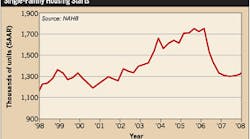Soaring high for five years, the single-family housing market consistently contributed to U.S. construction activity while the impetus for other sectors, such as commercial building and public works, came and went. But the bubble finally burst in 2006 at a much faster pace than analysts anticipated, leading to excess housing inventory and slowed construction starts across the nation. However, despite this year's expected rocky beginnings, economists predict the market will level out by mid-year.
The long demand for new homes has been driven by a combination of improved economic conditions and household wealth, lower mortgage rates, more inclusive credit underwriting, and favorable demographics, according to Wachovia Corporation Economics Group's “2007 Housing Market Outlook.” In the early part of the decade, Wachovia reported weakness in the stock market added to the residential market's attractiveness for homeowners and investors — sales of new single-family homes jumped 11.7% in 2003, 10.1% in 2004, and 6.6% in 2005. In 2005, single-family housing peaked at 1.716 million starts, according to the U.S. Census Bureau.
With investors increasingly attracted to the market, prices dramatically increased. “Speculative buyers poured into the housing market, much as they had into the market for tech stocks in the 1990s,” said Bernard Markstein, director of forecasting for the National Association of Home Building (NAHB).
According to Wachovia, virtually all growth in new home sales between mid-2004 and mid-2005 was due to investors. However, once they saw the devastation from Hurricane Katrina and began to hear tales of how it would slow the overall economy, many began to get nervous, said Mark Vitner, senior economist for Wachovia. “The swing in speculative activity, from buying to selling, turned the entire housing market,” Vitner said.
Contract cancellations doubled, even in markets where investor activity had been active the year before. But many investors wouldn't walk away from their deposits, closing on properties and trying to sell them at a loss. Builders were basically competing with their own product at a lower price. Once in demand, new homes became a source of over supply, contributing to the sharp drop in prices. The market retreated 15% in 2006 and is expected to decline another 7% in 2007.
Reed Construction Data's “U.S. Construction Outlook 2007-2008” stated that higher mortgage rates, higher monthly house payments due to tighter lending standards, and slower growth in the economy will keep housing starts near a 1.7 million-unit pace through 2008, but a dip is possible for several months before the current inventory surplus is absorbed. According to Reed's outlook, the surplus is currently equivalent to about 10 weeks of supply, but a dip in home sales — or a sour economic report that saps confidence — could quickly push the surplus to 12 weeks or more and prompt builders to cut production more sharply.
The demand for new and existing homes is, however, showing some signs of shoring up. Wachovia reported mortgage applications have been on the rise since August, and it is attributing the pickup to a drop in mortgage rates and aggressive discounts by homebuilders. It expects mortgage applications and sales to slide back during the first half of 2007 and bottom out around mid-year.
Markstein offered the same sentiments. “We're in the final throes of the adjustment process,” he said. “The demand side is firming up, new and existing home sales are holding steady, and builders are working through the inventory overhang.”
He added the adjustment process will continue through the first and second quarter before home construction activity starts pick up again (see chart).
While home inventories appear to have topped out, the U.S. Census Bureau's official numbers understate the problem. According to Wachovia, these homes form a shadow inventory that will likely hang over the housing market for some time, delaying any recovery in new construction. It's these understated inventory numbers that are largely having an effect on contractors. “From the contractor's point of view, new work will not be coming in quickly,” Markstein said. “So if you're offered a job, take it.”
He added the currently strong remodeling market may be the answer for contractors looking for work.



